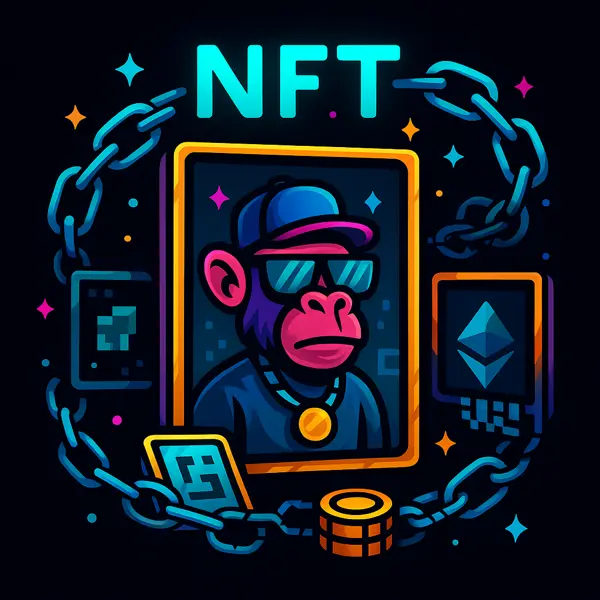Remember when Twitter was full of monkey profile pics selling for millions? That was NFTs. But NFTs aren’t just about overpriced art — they’re non-fungible tokens that prove ownership of digital (and even physical) assets. In 2021–2022, they became the face of crypto hype. By 2025, they’re evolving into gaming, music, tickets, and even real estate. Let’s break down what NFTs actually are, how they work, and why they still matter.
What Is an NFT?
NFT = Non-Fungible Token.
- Non-fungible: means unique, not interchangeable. One BTC = one BTC, but one NFT ≠ another NFT.
- Token: stored on a blockchain (mainly Ethereum, but also Solana, Polygon, and others).
Think of NFTs as digital receipts proving you own something — art, music, collectibles, in-game items, or even a house deed.
How NFTs Work
- Built mostly on Ethereum using the ERC-721 or ERC-1155 token standards.
- Stored on-chain or linked to metadata (image, video, music).
- Verified by smart contracts, so ownership is transparent and provable.
- Can be bought, sold, or transferred like any other token — but each one is unique.
The Main Types of NFTs
1. Art & Collectibles
- CryptoPunks, Bored Ape Yacht Club (BAYC), Azuki.
- Early projects became status symbols, some selling for millions.
2. Gaming NFTs
- Axie Infinity, Illuvium, Gods Unchained.
- In-game assets you can trade outside the game.
3. Music & Media
- Musicians drop albums as NFTs, fans get ownership + royalties.
- Platforms like Royal let fans buy shares of songs.
4. Tickets & Memberships
- Concert tickets as NFTs prevent fraud.
- DAOs issue membership NFTs for access to communities.
5. Real-World Assets (RWA)
- NFTs tied to real estate, cars, or luxury goods.
- Startups tokenize property deeds, making real estate tradable.
Why NFTs Took Off
- Flex culture: Owning BAYC or Punk was a digital Rolex.
- Creator royalties: Artists could earn from secondary sales forever.
- Community: NFT projects became tribes with events, merch, and metaverse hangouts.
- Speculation: Let’s be honest — early NFTs pumped hard, making early buyers rich.
The Crash & Evolution
After the 2021 mania, NFT volumes collapsed in 2022–2023. BAYC floor dropped from 150 ETH to under 30. But while hype died, the tech kept evolving:
- Gaming NFTs gained traction in Asia.
- Ticketing pilots in Europe proved NFTs solve fraud.
- Brands like Nike and Adidas built NFT sneaker lines.
By 2025, NFTs are shifting from pure speculation to real utility.
Risks of NFTs
- Scams: Fake collections, phishing links, rug pulls.
- Illiquidity: Hard to sell in bear markets.
- Hype cycles: Prices swing wildly with narrative shifts.
- Royalties fading: Marketplaces like Blur cut royalties, hurting artists.
Real-World Example
In 2021, Visa bought a CryptoPunk for $150k to make a statement. In 2024, Coachella experimented with NFT tickets that gave VIP perks and lifetime access. Meanwhile, millions in Asia play blockchain games where NFTs = actual income.
The Future of NFTs
- Gaming will dominate: True ownership of items will be standard.
- Music/creator economy: NFTs let fans invest directly in artists.
- Brands adoption: Nike, Adidas, Starbucks, and Gucci already launched NFT programs. Expect more.
- Identity: ENS names, profile badges, and digital IDs will likely be NFT-based.
Final Thoughts: More Than JPEGs
NFTs started as hype art projects, but they’re evolving into the digital ownership layer of Web3. From games to tickets to real-world assets, NFTs are becoming infrastructure, not just flexes.
Yes, many collections are dead. Yes, scams exist. But the core idea — digital assets you truly own and trade — isn’t going anywhere.
NFTs are how crypto culture meets mainstream adoption. And for degens, they’ll always be more than JPEGs. Wagmi. 🚀


